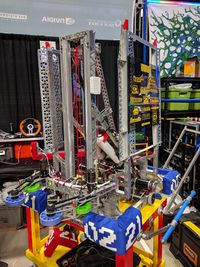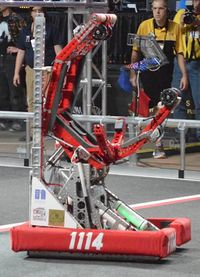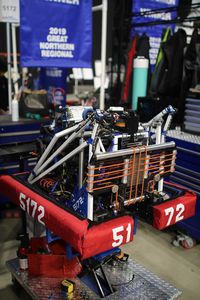Intakes
Contents
Description
An intake is a mechanism that brings game pieces from the field or human player into the control of the robot.
Design Considerations
Touch It, Own It
"Touch it, own it" is a concept used to describe an effective intake, although it is not a measurable metric. The moment a "touch it, own it" intake comes in contact with a game piece, it is "owned" by the robot such that it will never lose grip, fall out, or be stolen by another robot. It can be seen as somewhat of a buzzword.
Acquisition Zone
The acquisition zone or effective intake area is the size of the area in front of the robot where reliable intaking can happen. The larger the effective intake area, the more easily game pieces can be acquired and scored. A driver needs to be able to pick up a game piece from 50 feet away without direct line of sight, which a large acquisition zone is vital for. For a tank drive robot, measuring the width of the intake (parallel to the front bumper) is more important than measuring its length (perpendicular to the front bumper). For a swerve drive, the critical measurement is the total ground area under the intake where reliable intaking happens. A large intake is only valuable if the intake works reliably across the entire area. If a robot has a full width intake that jams when intaking at the sides, then a narrow intake would be more valuable.
Speed
Assuming that a roller intake is being used (as it almost always should), the surface speed of the roller(s) should be fast enough that the robot can pick up a game pieces when driving forward at full speed. For "single-contact" intake designs like the Top Roller, that means that the surface speed of the roller should be 2-4x the top speed of the robot. For "dual-contact" designs like the Top and Bottom Roller and Side Rollers, each roller's surface speed should be 1-2x the robot's top speed.
A simple equation to calculate an intake's rotational speed is:
Where:
Ω = The intake's rotational velocity in RPM
Vs = The intake's surface speed in feet per second (1-4 times the robot's maximum driving speed, depending on the type of intake used)
r = The intake's radius in inches
"Reasonable" values of rotational velocity can range from ~700 RPM (4" diameter roller used in a two-roller design on a slow robot) to ~12,000 RPM (1" diameter roller in a single-roller design on a fast robot). Once a value has been arrived at mathematically, it should be tested as much as possible. Each game piece and robot will behave differently, and will require tweaking and adjustment. Due to this, be careful to select motors and gearing capable of spinning faster than the calculated value.
Deployment
All parts of an FRC robot are typically required to start within the robot's frame perimeter. With few exceptions, an intake is unable to acquire game pieces from inside the frame perimeter. This means that intakes have to actuate outwards in order to fuction effectively. It is not always strictly necessary to be able to retract an intake, although game rules sometimes make it advantageous to do so, and parts outside the frame perimeter are always more succeptable to damage than parts protected by the bumpers. Whether or not the intake is deployed and whether or not it is retracted is a strategic choice. What type of deployment to use is a design choice and is discussed below.
Compression and Compliance
In order to grip a game piece, an intake needs to provide a compression force on it. In order to provide a compression force, either the intake or the game piece needs to be able to move or flex; this movement is called compliance. If a game piece is soft (such as the balls used in 2016, 2019, or 2020), the intake can be rigid because compliance comes from the game piece (although different amounts of compliance can still help - testing is required). As a starting point, flexible game pieces like the 2016, 2019, and 2020 balls should be compressed no more than 15%. If a game piece is hard (such as the boxes used in 2015 or 2018), an effective intake will always have compliance because the game piece is unable to flex out of the way. An intake that is more rigid will grip the game piece harder, but will require more torque from the motor to do so. A more flexible intake will grip the game piece less forcefully, but will put less torque on the motor and may be able to acquire a game piece in a more difficult position or orientation.
The range of motion of an intake and the force required to move it are both variables that should be tested in the prototyping stages of a design. If possible, they should be adjustable on a "final" design so that changes can be dialed in as the season progresses.
Release Method
In pick-and-place games like 2019, 2018 and 2011, many intakes were also used as scoring devices. While simply reversing the rollers works, the ability to release the game piece without reversing the rollers allows for greater precision when delivering the piece. This can be vital for effective gameplay, and should be considered in games where game piece placement requires careful precision.
Durability
Because intakes are often the only part of a robot extending past the frame perimeter, they need to be designed to take more abuse than most other robot parts. Compliant mounting and flexible parts are a popular way to keep intakes from taking damage when deployed. A robot should be able to drive into a wall at full speed without breaking anything critical.
Note: Because no part is perfectly durable, it may be worth intentionally designing a weak point into an intake at a point that's easy to fix. It's better for the rivets between two plates to shear rather than the plates themselves bending. Designed weak points should be strong enough not to break under normal use, but still the weakest point in the system. This can be a difficult design task, and should be considered by experienced designers in special cases.
Major Types
Note that not all intakes fit into these categories. When designing an intake, feel free to look at all options and think outside the box. The categories presented here describe trends, not rules.
Over Bumper
Description
An over-bumper intake reaches out past the bumpers, and pulls game pieces up and over the bumper into the robot. Over bumper intakes do not require a break in the bumpers, and usually use the pool noodles inside the bumpers to provide compliance to the intake. They can sometimes take up more space than a through-bumper intake, but can also be made wider than a through-bumper intake can for better pickup. An over bumper intake will almost always have to be actuated to extend out past the bumpers.
When to Use
Over bumper intakes should be considered the default option for any game where the robot may be required to intake more than one game piece at a time, and should be strongly considered for single-piece games with game pieces that are relatively small or can roll easily. Over bumper intakes are useful for robots that singulate game pieces inside the robot rather than outside. For this reason, over bumper intakes are a good choice for game pieces that are grippy against each other. Intaking over the bumpers means closing any gaps in the bumpers which could otherwise open the robot up to unnecessary damage. They should be avoided in cases where packaging is a significant problem for other mechanisms, where powering the extension is a problem (lack of pneumatics or PDB slots), or where the game piece is unwieldly enough that bringing it over the bumper is a significant challenge.
Examples
| Team 2102's 2020 robot with wide pivoting over-bumper intake | Team 254's 2020 robot with wide four-bar over bumper intake | Team 971's 2019 robot with wide four-bar over bumper intake | Team 1290's 2018 robot with pivoting over bumper intake | Team 2056's 2016 robot with wide pivoting over bumper intake |
Through Bumper
Description
A through bumper intake has a break in the bumpers through which game pieces travel into the robot. They can be easier to package because neither game pieces nor the intake itself has to travel up and over the bumpers, instead going through them. Intaking through the bumpers means that either the intake is narrower than it could be otherwise, or that the intake has to singulate game pieces to some degree before they enter the robot. Through bumper intakes can be made to extend past the bumpers, or remain behind the bumpers and protected by them.
When to Use
Through bumper intakes should be used in games where the robot only handles a single game piece at a time, or with multiple game pieces that slide easily over each other. They should be considered in games that will have heavy defense where protecting the intake is important, or on robots where available space above the bumpers is tight.
Examples
| Team 2102's 2018 robot with through bumper intake for power cubes | Team 118's 2017 robot with through bumper intake for both gears and fuel | Team 971's 2016 robot with through bumper mecanum intake | Team 971's 2013 robot with deployed through bumper intake | Team 148's 2009 robot with through bumper intake |
Roller Intakes
Roller intakes use one or more spinning rollers or wheels to push game pieces in towards the robot. A well designed roller intake requires a minimum of precision from the robot and driver, and can intake multiple game pieces continuously without discrete repeated motions.
When to Use
Almost always. Roller intakes have dominated the landscape in FRC since at least 2011, and for good reason.
Top and Bottom Roller
These intakes have two counter-rotating rollers rotating on an axis parallel to the ground, in which a game object is sucked in between. Frequently used to intake inflatable game objects, such as those from the 2007 and 2011 FRC games. This style requires the game object to be kicked up over the bottom roller and then is sucked into the claw. It tends to be more effective on game objects with a larger radius on the bottom edge than it is on smaller or more square objects. (Credit to NASA Robot Design Guide)
Top and Bottom roller intakes are relatively uncommon.
| Team 930 were championship finalists in 2019 | Team 1114 had one of the most dominant robots of 2014 | Team 254's 2011 robot with top and bottom roller claw | Team 111's 2011 robot with top and bottom belted rollers |
Top Roller
These intakes consist of at least one horizontal roller rotating on an axis parallel to the ground. Many times this style consists of more horizontal rollers behind the main front roller that guide the game pieces into the correct part of the robot. (Credit to NASA Robot Design Guide)
These are often used with spherical game pieces or with flat game pieces that will slide well on the ground like Hatch Panels and Gears. When used with flat game pieces, they often have dustpans under the roller to control the game piece.
| Team 2056's 2019 robot had a top roller with a fixed bar underneath it, acting like both a kicker bar and dustpan. | Team 254's 2017 robot won the first and only Festival of Champions | Team 118's 2016 robot had a forward roller for reach with a row of mecanum wheels in back to center the ball into the robot. |
Side Rollers
These intake have a roller intake architecture consisting of two or more sideways rollers rotating on an axis nominally perpendicular to the ground that intakes a game object into a robot. (Credit to NASA Robot Design Guide)
Side rollers should only be used with game pieces that don't roll easily like Boxes. Side roller intakes have a tendency to push game pieces laterally to the sides rather than into the robot, and because of that should have side-to-side compliance to help center game pieces effectively. They were most prominently used in the 2015 and 2018 FRC seasons.
| Team 1684's wheeled hatch grabber in 2019 was incredibly effective, and is arguably a side roller intake. | Team 1323's 2018 intake was so successful that it was copied by many other top teams. | Team 971's 2018 robot had spring loaded arms to help draw cubes into the robot. | Team 1114's 2015 robot was one of the most dominant robots in history, partially because of its incredibly effective intake. |
Vectored Wheels
Vectored wheels like mecanum drive wheels, Thriftybot's | VIWs, and Armabot's eccentric VIW can be used to center a game pieces on a shaft. When these spin, instead of pushing a game piece in the same direction as the shaft, they push the game piece at an angle. This design detail works great with single-game-piece games. When used with multi game piece games, the intake can act as a serializer. This should only be done with game pieces that slide well against each other, otherwise intake jamming will be a problem as it was for teams in 2012 and 2020.
Kicker Bars
Kicker bars are bars or plates that sit between a top roller and the bumper. They keep the robot from riding up on top of the game piece by lowering the contact point. They can also help control compression on a game piece for a faster, smoother intake. They should be used in cases where there is a risk of the robot riding up over game pieces, or where the amount of compression on the game piece without the kicker bar is unacceptably high. Deployment mechanisms for kicker bars can be challenging, but they can also be deployed separately from the rest of the intake, or left deployed throughout the match.
Dustpans
Dustpans are flat horizontal planes that sit just above the carpet. They help support the game piece from the bottom, and are helpful with game pieces that are flat, heavy, or otherwise awkward to handle.
CD7
The term "CD7" refers to the intake used on Team 47 (team Chief Delphi)'s 7th robot in 2002. It had a series of sideways belts to the left and right of a central belt, so that game pieces would draw in from the sides into the center, where it was pulled into the robot. They are complicated to build, but effective when implemented well.
| Team 5172 successfully built a CD7 intake in 2020. Video of robot details | Team 4329's shows a good, clear view of a CD7 intake. | Team 27 used a CD7 intake for the 2008 game | Team 47 pioneered this style of intake, and it caries their name to this day. |
Claws and Pinchers
Only use these in extremely rare circumstances. You must have a very, very, very good reason to use a non-roller intake. They were common in older FRC games, especially when the rules had tight restrictions on motor use. Hatch grabbers in 2019 are the only modern, effective example of non-roller intakes (although there were effective roller variants of these as well). Non-roller hatch grabbers were viable because hatches had unusual geometry, and were almost always loaded from the human player station which put them in a consistent position and orientation, with good visibility from the driver.
Designing an Intake
Relevant Information
References
JVN Blog's Intake Iteration article

























